Introduction
Have you ever wondered how we can store renewable energy or produce hydrogen fuel? The answer lies in a fascinating process known as electrolysis, carried out by devices called electrolyzers. Let’s dive into the world of electrolyzers and see how they work, shall we?
The Basics of Electrolysis
Electrolysis Process
Electrolysis is a process that uses electricity to drive a non-spontaneous chemical reaction. In other words, it breaks down compounds into their constituent elements.
Components of an Electrolyzer
At its core, an electrolyzer consists of two electrodes (an anode and a cathode) immersed in an electrolyte. When an electric current is applied, it initiates a reaction that splits water into hydrogen and oxygen gases.
Types of Electrolyzers
Alkaline Electrolyzers
This is the most common and mature technology. They use a solution of water and potassium hydroxide as the electrolyte. The main advantage is their durability and lower cost, but they require pure water and have slower reaction times.
Proton Exchange Membrane (PEM) Electrolyzers
PEM electrolyzers use a solid polymer as the electrolyte and can operate at higher pressures. They are more efficient than alkaline electrolyzers and can quickly start and stop, making them ideal for variable renewable energy sources.
Solid Oxide Electrolyzers
These operate at high temperatures using a ceramic material as the electrolyte. The high temperature allows for higher efficiencies and the ability to use steam instead of liquid water. However, the materials required make these electrolyzers more expensive.
